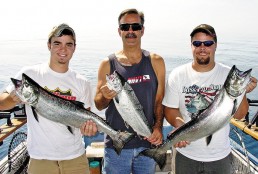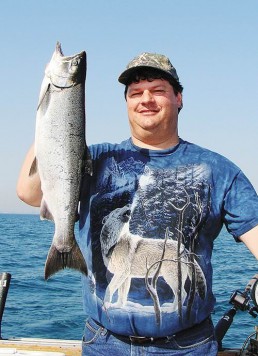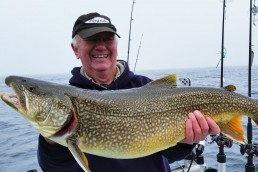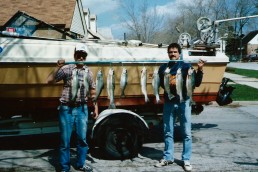SHARE THIS POST
For Lake Michigan salmon and trout fishermen, July is the month when we usually head offshore in search of the fish. Earlier in spring, coho salmon and brown trout are caught in large numbers by anglers fishing close to shore in shallow water. During midsummer, however, trollers in deep water catch cohos and chinooks, as well as lake trout and steelhead.
In July, warming water temperatures cause the cold-water trout and salmon to move farther offshore and cruise deeper in the water column. At the beginning of the month there may be schools of cohos hanging around several miles from shore. By the end of July, however, the same schools may be found much farther offshore—sometimes as far out as 15 to 20 miles.
Once you find a concentration of fish, the action can be dynamite. Quick limits are possible for trollers, and since the catch is typically made up of multiple species, there could be a wide range of sizes in the cooler.
To have consistent success in summer, you must be willing to search. Since the salmon and trout are on the move, they can be hard to find. The best always have a plan, and if you hit the water without one you may go home with an empty cooler.
Finding silver fish
Your “fish-finding” plan may be as simple as using other boats as an indicator of schooling fish. There are times when a hot school of salmon can be found by visually locating a big pack of boats and then trolling near them. Other boats can help by giving out important information over a marine radio. It’s always good to listen to radio chatter to see where fish are biting.
Using your other electronics is a better way to find the fish. Depth finders have evolved into sophisticated pieces of equipment for the Great Lakes angler, and most include GPS functions in addition to their normal sonar capabilities. Most captains plan to head for specific GPS coordinates when they leave the marina in the morning. They can even return to a productive area from the previous day by recording and using the GPS numbers for that particular spot.
Once you are out on the water, watch your sonar screen closely for signs of fish. Individual salmon and trout can often be seen on the screen, so keep an eye out for the telltale “arcs” that indicate their presence. Silver fish (troller’s term for salmon and trout) also congregate around schools of baitfish, so dark “clouds” of bait on the screen is another good sign. As soon as baitfish appear, stop the boat and start setting lines.
Unfortunately, there will be many times when you get out to the fishing grounds and you don’t see anything positive on the sonar screen. Go ahead and start trolling and watch the screen for any signs of baitfish or larger fish. It is very common to get the rods set and then see isolated pods of baitfish on your sonar as you are slowly trolling along. Mark that spot with your GPS unit and then work the area thoroughly.
Are you enjoying this post?
You can be among the first to get the latest info on where to go, what to use and how to use it!
Targeting suspended fish
Once you find the fish or see schools of baitfish on the sonar, it is time to start setting rods. Since the fish are suspended, it is very important to get your lures down to the level of the fish. Keep in mind, fish tend to look up rather than down, so it is far better to set your lures a little too high than too low.
The most common method of reaching suspended fish is to use downriggers. Downriggers are a steel rod and a large reel spooled with stout wire with a heavy lead weight at the end to take the lure down into the depths and hold it there. Electric downriggers are more convenient than manual models, but both get the job done.
Use your electronics to help you determine how deep to set the lines with the downriggers. If the water is 70 feet deep and you see a school of baitfish hovering on the screen between 20 to 35 feet, set your downriggers accordingly to target the productive area. Most boats are equipped with four downriggers, so a good spread would include one lure set at 16 feet, another at 20, a third set right in the middle of the baitfish at 27 feet and the last lure set at 36 feet (to catch any fish cruising just below the school of bait).
Coho and trophy-sized Chinook salmon routinely haunt the edges of baitfish schools, but don’t forget about tackle-busting steelhead. These can be found cruising over the top of baitfish or beneath them, along with the occasional lake trout. Silver-colored spoons that resemble the baitfish (alewives, gizzard shad) work well, but dodger-and-fly combinations can be hot.
You can also set a couple of rods with Dipsy Divers in addition to the downrigger rods. These directional divers pull the lures down and away from the boat and you can experiment with different depths until you find one that is productive. Many reels come equipped with line counters, and that is a handy feature to have when fishing for suspended trout and salmon. If you hook and land a fish with 75 feet of line out (according to the line counter), it is very easy to reset that rod at exactly 75 feet to duplicate the conditions that led to the strike.
Rods equipped with leadcore line are another good option for targeting suspended fish. Some trollers run one leadcore line straight back behind the boat, while others use planer boards to run a leadcore rod off of each side. A good rule of thumb is that lures on leadcore will sink about 5 feet per color (10 yards of line) while trolling. Of course, this depends a great deal on trolling speed and the type of lure being used, so use that guideline to estimate the depth you are fishing.
This is a great time to be out on Lake Michigan. The fish may not be as easy to find as they are in March and April, but once you find them the action can be fast and furious. You also have a better-than-average chance of hooking a real trophy out there in the offshore waters, so be ready.
MWO
SHARE THIS POST
Did you enjoy this post?
You can be among the first to get the latest info on where to go, what to use and how to use it!
Tom Berg
A lifelong outdoorsman and award-winning outdoor writer and nature photographer, Tom Berg has been the Executive Director/Treasurer of the Hoosier Outdoor Writers group for the past 14 years. When he is not writing, he would rather be outside fishing, hunting or trapping than doing just about anything else.




